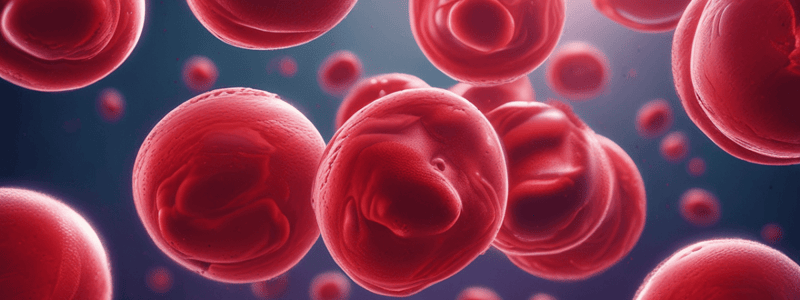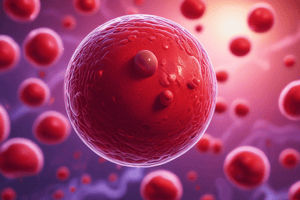Podcast
Questions and Answers
What is the primary function of red blood cells (RBCs)?
What is the primary function of red blood cells (RBCs)?
- To provide the body's blood with its distinctive color
- To transport carbon dioxide from the tissues to the lungs
- To produce the hormone erythropoietin
- To transport oxygen from the lungs to the tissues of the body (correct)
What is the average lifespan of a red blood cell (RBC)?
What is the average lifespan of a red blood cell (RBC)?
- 120 days (correct)
- 90 days
- 30 days
- 60 days
What is the process by which red blood cells (RBCs) transport oxygen and carbon dioxide?
What is the process by which red blood cells (RBCs) transport oxygen and carbon dioxide?
- Oxygen and carbon dioxide are exchanged directly through the RBC membrane
- Oxygen binds to hemoglobin in the RBC, and carbon dioxide is transported back to the lungs for exhalation (correct)
- Oxygen and carbon dioxide are both transported by the RBC through diffusion
- Oxygen is transported to the tissues and carbon dioxide is carried back to the lungs by the plasma
What is the purpose of a complete blood cell count (CBC) in relation to red blood cells (RBCs)?
What is the purpose of a complete blood cell count (CBC) in relation to red blood cells (RBCs)?
What is the primary reason for the transfusion of packed red blood cells (PRBCs)?
What is the primary reason for the transfusion of packed red blood cells (PRBCs)?
What is the most common type of acute transfusion reaction?
What is the most common type of acute transfusion reaction?
Which of the following is a potential manifestation of a transfusion reaction?
Which of the following is a potential manifestation of a transfusion reaction?
When can delayed transfusion reactions occur?
When can delayed transfusion reactions occur?
Which delayed transfusion reaction is often fatal?
Which delayed transfusion reaction is often fatal?
Which of the following is NOT a potential manifestation of a transfusion reaction?
Which of the following is NOT a potential manifestation of a transfusion reaction?
What is the universal donor blood type?
What is the universal donor blood type?
What is the purpose of crossmatching a client's blood with the donor blood?
What is the purpose of crossmatching a client's blood with the donor blood?
How long should a nurse remain with the client during a blood transfusion?
How long should a nurse remain with the client during a blood transfusion?
What should the nurse do if a transfusion reaction is suspected?
What should the nurse do if a transfusion reaction is suspected?
What is the maximum time a blood product can be safely transfused?
What is the maximum time a blood product can be safely transfused?
What is the typical increase in hemoglobin level after a transfusion of a unit of packed red blood cells (PRBCs)?
What is the typical increase in hemoglobin level after a transfusion of a unit of packed red blood cells (PRBCs)?
What is the typical increase in hematocrit level after a transfusion of a unit of packed red blood cells (PRBCs)?
What is the typical increase in hematocrit level after a transfusion of a unit of packed red blood cells (PRBCs)?
What is the primary purpose of administering granulocyte transfusions?
What is the primary purpose of administering granulocyte transfusions?
What is the typical platelet count threshold for administering a platelet transfusion?
What is the typical platelet count threshold for administering a platelet transfusion?
What is the primary function of plasma in the body?
What is the primary function of plasma in the body?
Flashcards are hidden until you start studying




